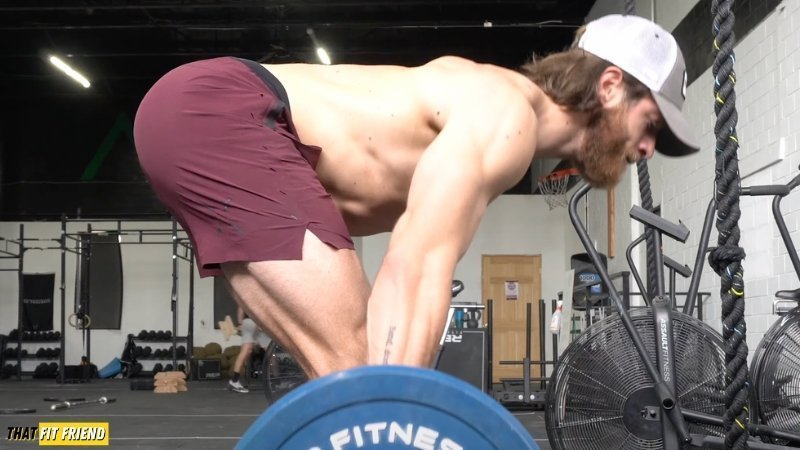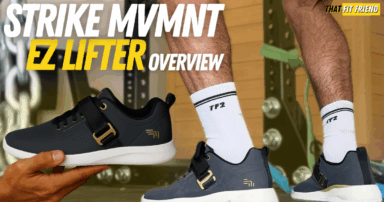If you want to strengthen and increase the mass of your hamstrings and glutes, then Romanian deadlifts (RDLs) should have a place in your workout program. They can be a great staple exercise for lifters with all types of goals.
How To Do Romanian Deadlifts
Step 1: Firmly grip the weight you’re using
Whether you’re using a barbell, dumbbell, or form of weight. You’ll want to firmly grip the weight without over-flexing the wrists. Think about letting the weight, arms, and wrists hang vertically from the ground.
Step 2: Hinge and push the hips back
Start your rep by breaking at the hips and hinging. Think about pushing the hips back slowly as if a string is pulling them back. Let the arms track vertically with the floor keeping the weight relatively close to your body.
Step 3: Lower until your hamstrings run out of range of motion
With the hips hinged back and the knees with a soft bend, lower the weight slowly and in control until you start to feel your torso flex. You want to work through a range of motion that focuses tension on the hamstrings.
If your torso is flexing, then you may be working past the range of motion that will bias and keep tension on your hamstrings and glutes. This can be counterproductive, and there is not always more from Romanian deadlifts.
Step 4: Stand back up and bring your hips through
Once you’ve hit your end range of motion, stand back up slowly keeping the weight and arms vertical with the floor. Think about bringing your hips to the bar and squeezing the glutes. This will keep tension in the hamstrings and glutes.
Romanian Deadlift (RDL) Benefits
The Romanian deadlift comes with multiple benefits, and their benefit for your training will ebb and flow based on your goals. For example, if your goal is building stronger hamstrings then an RDL should take a high priority in your workout program.
Below I’ll discuss three of my favorite Romanian deadlift benefits that can have carryover for every type of athlete and lifter.
1. Great for Strengthening the Hamstrings and Glutes
The first and arguably most notable Romanian deadlift benefit is their ability to strengthen the glutes and hamstrings. When you perform RDLs you put a large degree of stretch and stress on the hamstrings and glutes sequentially.
This stretch during the eccentric (lowering) movement pattern can train the hamstrings to be strong and stable when extending and lengthening. For sports, this can have carryover for sprinting, jumping, and basically doing anything lower-body related.
In the real world, stronger hamstrings and glutes from a lengthened context can have carryover for how you move and pick things up off the ground. Plus, they can contribute to our knee and hip stability when going about our day to day.
There’s also the component of how stronger hamstrings can help with yielding strength, which, in practice, is how our hamstrings help control and absorb force and our center of mass when placed under stress in lengthened positions.
In my opinion, if you’re working to strengthen your hamstrings, then having and utilizing an RDL variation in your program with other forms of hamstrings training is non-negotiable.
2. Awesome for Improving the Size of the Posterior Muscles
Outside of strengthening the posterior muscles, RDLs can be great from a hypertrophy context. When it comes to hypertrophy strengthening, a blend of eccentric (lengthening) and concentric (shortening) bias exercises is a must for building mass.
An RDL’s ability to put stress on the hamstrings and glutes is fantastic for those wanting to train these muscles through their full range of motion. Additionally, studies have continually noted that eccentrics are fantastic for creating muscular hypertrophy.
This is also why you’ll see lifters program tempos with RDLs to slow themselves down to ensure they’re putting as much stress as they possibly can as the hamstrings work against gravity to control the load we’re holding and using.
By lengthening the hamstrings and glutes with progressively overloaded RDLs, we’re stretching and stressing the muscular fibers that will then need to repair to build back bigger and stronger.
3. Useful for Strengthening Our Hip Hinge Mechanics
The hip hinge is a fundamental movement pattern that I think everyone should be familiar with and proficient with. How we bend at the hips to create and mitigate force is important in multiple walks of life.
Whether you’re picking something up off the ground when doing yard work or playing a sport, having some level of understanding of hip hinges and foundational mechanics can be useful.
The RDL is an exercise that will focus and hone in on your ability to hip hinge. For example, if you can’t hip hinge well, then your RDLs will reflect that with the intensity you’re using and help you improve over time.
Romanian Deadlift (RDL) Muscles Worked
The Romanian deadlift will be an exercise that primarily targets and builds the posterior muscles like the hamstrings, glutes, erectors, and even muscles like the calves.
That said, yes, the RDL will passively train muscles on the ground of the body like the tibialis anterior and quads as they’re needed for stability purposes, but when you think RDL, think posterior muscle bias.
Barbell RDL vs Dumbbell RDL
When discussing Romanian deadlift variations, the barbell and dumbbell RDL are two of the most popular variations that lifters will program and perform for strength and mass.
Both variations can be great and they each have their own lists of pros and cons which will be contextually dependent on your goals, training age, and intention.
In the context of form and movement patterns, the major difference between the barbell RDL and dumbbell RDL is that you have to focus on clearing the knees with the barbell RDL, whereas with dumbbells, you can more easily manipulate their position.
For example, you can perform dumbbell RDLs with the dumbbells directly in front of the shins, angled slightly, or even by the side. They give you a little more free range and can be a little more beginner-friendly in doing so.
Barbell RDL Vs Dumbbell RDL Breakdown
- Best for Strength: Both. However, you can load barbell RDLs heavier.
- Best for Hypertrophy: Both.
- Best for Beginners: Dumbbell RDL.
- Best for Athletes: Both. However, dumbbell RDLs can sometimes be easier to perform.
In my coaching opinion, you’ll want to experiment with both of these RDL variations and run them for different training blocks to see which you respond best to regarding strength and mass.
Frequently Asked Questions (FAQ)
Q:Do RDLs build muscle?
Q:Are Romanian deadlifts for back or legs?
Q:Are RDLs good for glutes?
Q:Do you squeeze glutes at top of RDL?
Takeaway Thoughts
When it comes to well-rounded hamstrings and glutes, the RDL is arguably a non-negotiable that should be performed. This exercise can be a fantastic pick for lifters at all skill levels wanting to improve their strength and mass.
Another great thing about RDLs is that they can be highly versatile with their variations so there’s more than likely an RDL variation that will suit your needs, wants, and skill level really well.
If you have additional questions about the Romanian deadlift or want your form looked at, feel free to comment below or reach out to me on Instagram (@jake_boly or @that_fit_friend).


















Add a Comment